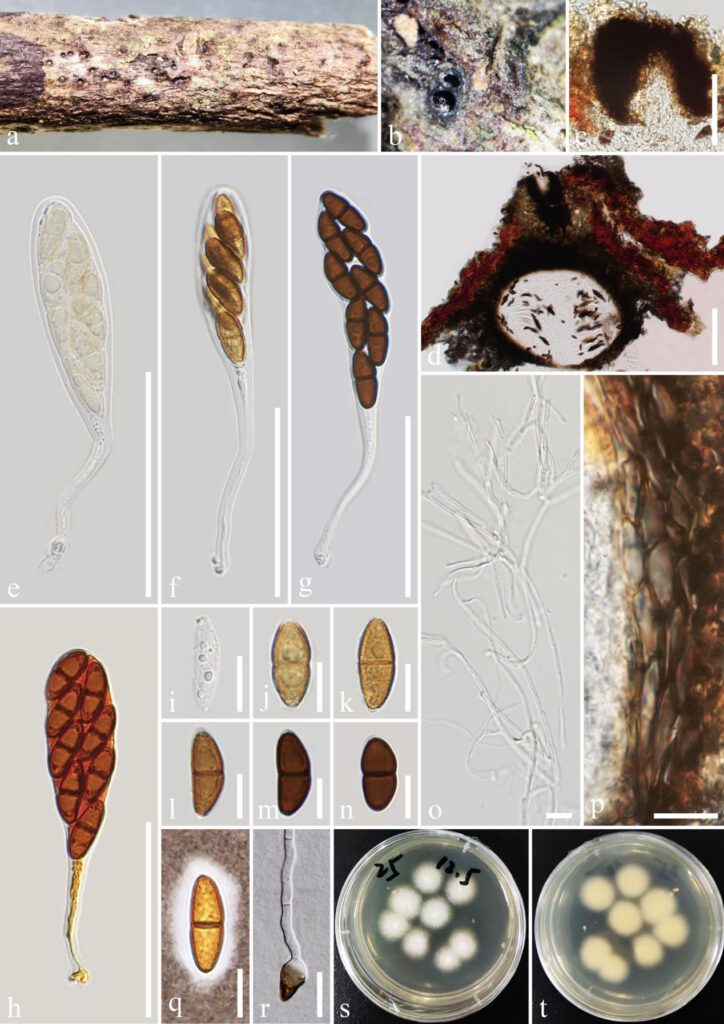Montagnula aquilariae T.Y. Du & Tibpromma, sp. nov. (Fig.X)
MycoBank number: MB;Index Fungorum number: IF; Facesoffungi number: FoF 12850;
Holotype: HKAS 124186
Etymology: Named after the host genus Aquilaria from which holotype was collected.
Saprobic on dead twigs of Aquilaria sinensis. Sexual morph Ascomata 300–450 × 300–420 μm (x̄ = 380 × 361 μm, n = 5), immersed, solitary to gregarious, mostly gregarious, subglobose to globose, black, with a long ostiole. Ostiole 100–180 × 60–160 μm (x̄ = 147 × 117 μm, n = 5), central, straight, dark brown to black, without periphysate. Peridium 20–60 μm wide, fused with host tissues, thick-walled, pale brown to dark brown cells of textura angularis. Hamathecium comprising 1.5–2 μm wide, numerous filamentous, branched, septate, guttulate, trabeculate pseudoparaphyses. Asci 45–75(–88) × (13–)15–20 μm (x̄ = 60 × 18 μm, n = 30) (spore-bearing part), bitunicate, 8-spored, elongate-clavate, slightly curved, with a furcate, 45–70 μm long pedicel. Ascospores 17–20 × 7–10 μm (x̄ = 19 × 8 μm, n = 30), uni-to bi-seriately, fusoid or ellipsoid, straight or slightly curved, 1-septate, slightly or strongly constricted at the septum, widest at the centre, tapering towards ends, hyaline to yellow when immature, become brown to dark brown when mature, turns reddish-brown in Melzer’s reagent, guttulate, with a thin mucilaginous sheath. Asexual morph: Undetermined.
Culture characteristics: Ascospores germinating on PDA within 24 h at 28℃, germ tubes produced from both upper and lower cells. Colonies on PDA reaching 6 cm diam., after one weeks at 28℃, mycelium white, flossy, circular with the entire edge, with filiform margin; white in reverse.
Material examined: China, Yunnan Province, Xishuangbanna, on dead twigs of Aquilaria sinensis (Thymelaeaceae), 13 September 2021, T.Y. Du, YNA25 (holotype, HKAS 124186; ex-type cultures, KUNCC 22-10815 = KUNCC 22-10816).
GenBank numbers: LSU: XXXXXX; ITS: XXXXXX; SSU: XXXXXX; TEF1: XXXXXX.
Notes: In the present phylogenetic analyses, M. aquilariae forms a separate branch with modulate bootstrap support within Montagnula. In morphology, M. aquilariae resembles to M. opulenta in having immersed ascomata, branched and septate pseudoparaphyses, and ascospores with a mucilaginous sheath. However, they are different in M. aquilariae has trabeculate pseudoparaphyses, and ascospores uni or bi-seriate, slightly or strongly constricted at the septum, while M. opulenta has cellular pseudoparaphyses, and ascospores bi-seriate, strongly constricted at the septum (Aptroot 1995; Wang 2000). In addition, the size of ascomata of M. aquilariae is smaller than that of M. opulenta (300–450 μm vs 400–1200 μm) (Aptroot 1995). Therefore, based on both phylogenetic analyses and morphological comparison, M. aquilariae associated with Aquilaria sinensis is introduced as a new species from China.

Fig. X Montagnula aquilariae (HKAS 124186, holotype). a, b Appearance of ascomata on host. c Section of an ostiole. d Section of an ascoma. e–g Asci. h An ascus stained by Melzer’s reagent. i–n Ascospores. o Pseudoparaphyses. p Peridium. q An ascospore stained by India ink. r A germinating ascospore. s, t. Colonies on PDA medium (after one week in culture). Scale bars: c = 100 μm, d = 200 μm, e-h = 50 μm, i-o = 10 μm, p = 20 μm, q = 10 μm, r = 20 μm.
